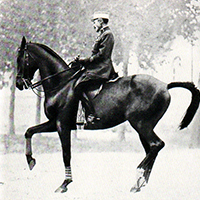Who's Who

Decarpentry, General
Discipline : Dressage
Born : 1878
Died : 1956
He was born to be a ‘Baucherist’ – both his father and grand-father were enthusiastic pupils of François Baucher. Serving in the cavalry, he was wounded in action in WWI, but played down an injury to his elbow saying that it kept his arm bent in the correct position for riding. He rose to be the commander of cavalry at Saint-Cyr and second in command at the Cadré Noir from 1925 to 1931. From 1939 onwards, General Decarpentry officiated as an international judge and he became the President of the FEI dressage committee.
According to Martin Diggle (Encyclopedia of Dressage): “As a rider and equestrian thinker, Decarpentry was by no means confined by the Baucherist influences of his childhood, as both the references cited in his book Academic Equitation show and the text itself shows. It is also evident that he took innovative advantage of the then-young techniques of cinematography to help analyse equine movement. Decarpentry was a modest man and, although held in great esteem as a rider, he had no desire to participate in competition, his legacy being the skill of his instruction, his work in developing the FEI and the integrity and scholarship he applied to his equestrian writing.”
According to Silke Rotermann: The first person to unite successfully the contrasting French approaches whilst developing their practicability within the sport was General Albert-Eugène-Édouard Decarpentry (1878-1956). A very skilled rider, Decarpentry was a multiple Olympic dressage judge and had co-written the first FEI dressage rule book in 1929 before he published his reference-book “Academic Equitation” exactly 20 years later. In this manual Decarpentry synthesised the best of the methods of L’Hotte, Baucher and de la Guérinière into a systematic and effective approach which was also totally suitable for the ever-growing sport of dressage. Decarpentry developed the rules for competitive dressage with German General von Holzing-Berstett and used them as a reference point for his manual. Decarpentry also used elements of Gustav Steinbrecht’s “Gymnasium of the Horse” which is the German “equestrian bible” to this day and whose author was known for his low opinion of 19th century French equitation. Decarpentry integrated several traditional elements of French dressage training, like flexions, hand-work and long-lining into his manual.
Until General L’Hotte wrote “Questions Equestres” it was hard, if not impossible to speak of a uniform French approach to equitation. Decarpentry remarked “that modern French School owes everything to him.” Decarpentry himself went one step further by paying attention to the necessities of competitive riding without neglecting the French tradition. Therefore Decarpentry can be considered as the “father” of the modern “classical French approach”, even though he modestly denied having written a “a corpus of a doctrine,” considering it rather as a “catalogue of procedures.”
Decarpentry sets out his aims in Academic Equitation:
The first aim of academic equitation is to restore to the mounted horse the gracefulness of attitudes and movement which he is possessed when he was free, but which becomes marred by the weight and interference of the rider.
To the solely utilitarian education which he has received in order to become serviceable, it adds, in the first place, the exercises of the ‘low school’, gymnastics intended to re-establish the regularity of his gaits and the straightness of his deportment.
It claims, thereafter, in the words of Newcastle, ‘to improve on Nature by the subtlety of Art’.
It then subjects the those to the progressive lessons of an aesthetic education destined to develop the rhythm and harmony of his movements, so that they are brought to a degree of ‘stylised’ perfection which will gradually transform them into the ‘airs’ of high school, though their essential characteristics are scrupulously respected.
Equestrian art thus, is akin to choreographic art, and the high school to classical dancing.
Publications:
Academic Equitation (1949)
